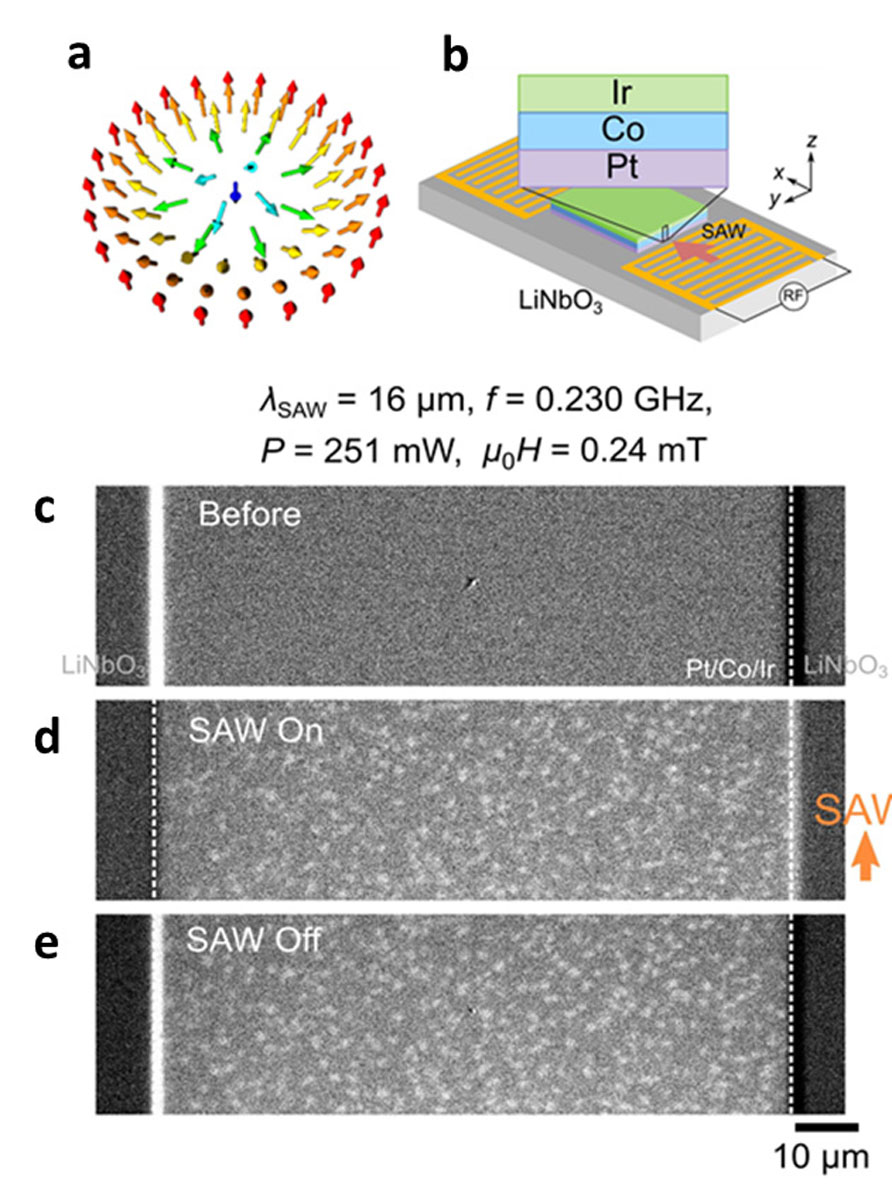Creation of Magnetic Skyrmions by Surface Acoustic Waves
Otani Group
Non-collinear and non-coplanar spin textures, such as chiral domain walls and helical or triangular spin structures, bring about diverse functionalities. Among them, magnetic skyrmions, particle-like non-coplanar topological spin structures characterized by a non-zero integer topological charge called the skyrmion number (Nsk), have great potential for various spintronic applications, such as energy-saving, non-volatile memory, and non-von Neumann devices. Current pulses can nucleate skyrmion in thin-film samples but require relatively large current densities, which probably causes Joule heating. Moreover, skyrmion creation is localized at a specific position in the film, depending on the sample design. Here, we experimentally demonstrate an approach to skyrmion creation employing surface acoustic waves (SAWs); in asymmetric multilayers of Pt/Co/Ir, propagating SAWs induce skyrmions in a wide area of the magnetic film (Fig. 1a,b). We use multilayer films of Pt/Co/Ir in which the formation of thermodynamically stable skyrmions has already been well-studied in previous research. All measurements were performed at room temperature, and the magnetic field (H) was applied perpendicular to the film plane. Firstly, we determined, from magnetic images taken before and after the application of SAWs at various H, the magnetic field Hsk at which skyrmions begin to appear in the ferromagnetic state without SAWs. The magnetic field evolution of polar Kerr images in a Pt/Co/Ir film with the nominal Co thickness of dCo = 0.55 nm shows that maze domains firstly appear at μ0H = 0.01 mT and transforms to thermodynamically stable skyrmions 3 μm in diameter at 0.21 mT. A further increase in H makes the skyrmions annihilate and leads to the ferromagnetic state at μ0H = 0.31 mT. Here, we note that the size of the observed skyrmions is relatively large, indicating that the dipole-dipole interaction plays an essential role in their stabilization, in addition to the interfacial DMI, and these types of skyrmion are sometimes called a ‘skyrmion bubble’.
Figures 1c–e represent the magnetic images before and during excitation by the propagating SAWs. Before exciting with SAWs, we observe no magnetic contrast (Fig. 1c), which indicates that the sample is in the single-domain ferromagnetic state. When the SAW is continuously excited, skyrmions appear (Fig. 1d); skyrmions are nucleated over almost the whole region of a rectangular-shaped Pt/Co/Ir film of width 100 μm and length 400 μm because of the long propagation length of the SAWs. Even after turning off the SAW, most of the skyrmions survive, indicating the emergence of metastable skyrmions (Fig. 1e). The density (nsk) of the nucleated skyrmions in the ferromagnetic state gradually increases with RF power above the threshold of P = 100 mW (Fig. 2a). When H is close to Hsk, the number of skyrmions dramatically increases after exciting with SAWs. Besides, when the skyrmions coexist with the ferromagnetic state before exciting with SAWs, that is, H < Hsk, skyrmions are also created. The value of nsk after exciting with SAWs is much larger than that before exciting with SAWs (Fig. 2b). In contrast, skyrmions cannot be created in the high field region. This is probably because, in the high field region, the energetically stable ferromagnetic state cannot accommodate skyrmions due to the gain in Zeeman energy, even when SAWs are excited.

Fig. 1. a, Schematic spin configuration of Néel skyrmion. b, Schematic illustration of the device structure. Pt/Co/Ir films are deposited on LiNbO3 substrates, and interdigital transducers (IDTs) are fabricated on both sides of a rectangular-shaped Pt/Co/Ir film. Surface acoustic waves (SAWs) are excited by applying radio-frequency (RF) voltage to IDTs. c-e, Polar Kerr images before (a), during (b), and after (c) exciting a propagating surface acoustic wave (SAW) with the wavelength (λSAW) of 16 μm by applying radio-frequency (RF) voltage with the power (P) of 251 mW. The white dashed lines represent the boundaries between Pt/Co/Ir film and LiNbO3 substrate. The orange arrow represents the propagation direction of SAW.
Micromagnetic simulations reveal that inhomogeneous torque arising from both SAWs and thermal fluctuations creates magnetic textures, with pair structures consisting of a Néel skyrmion like and an antiskyrmion-like structure. Subsequently, such pairs transform into a Néel skyrmion due to the instability of the antiskyrmion-like structure in a system with interfacial Dzyaloshinskii–Moriya interaction. Our findings provide a tool for efficient manipulation of topological spin objects without heat dissipation and over large areas, given that the propagation length of SAWs is of the order of millimeters.
References
- [1] T. Yokouchi, S. Sugimoto, B. Rana, S. Seki, N. Ogawa, S. Kasai, and Y. Otani, Nat. Nanotechnol. 15, 361 (2020).

